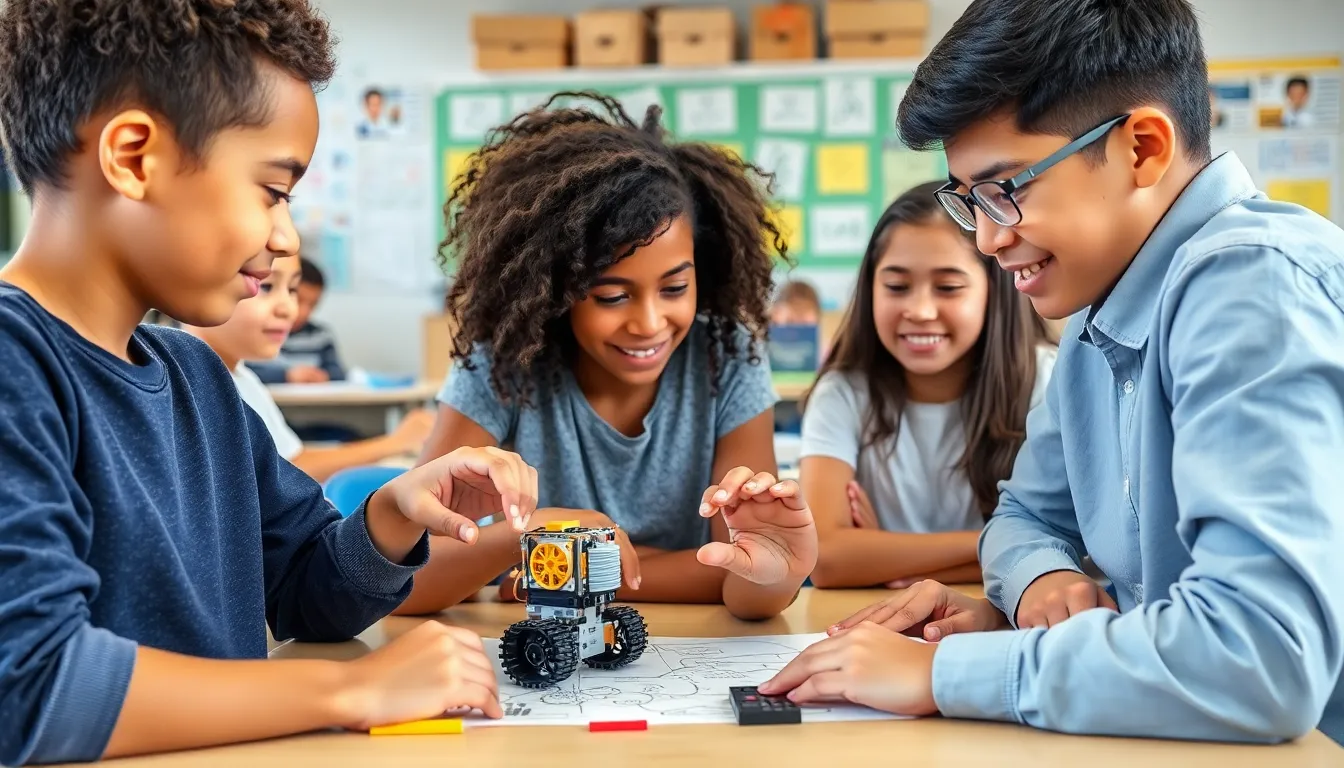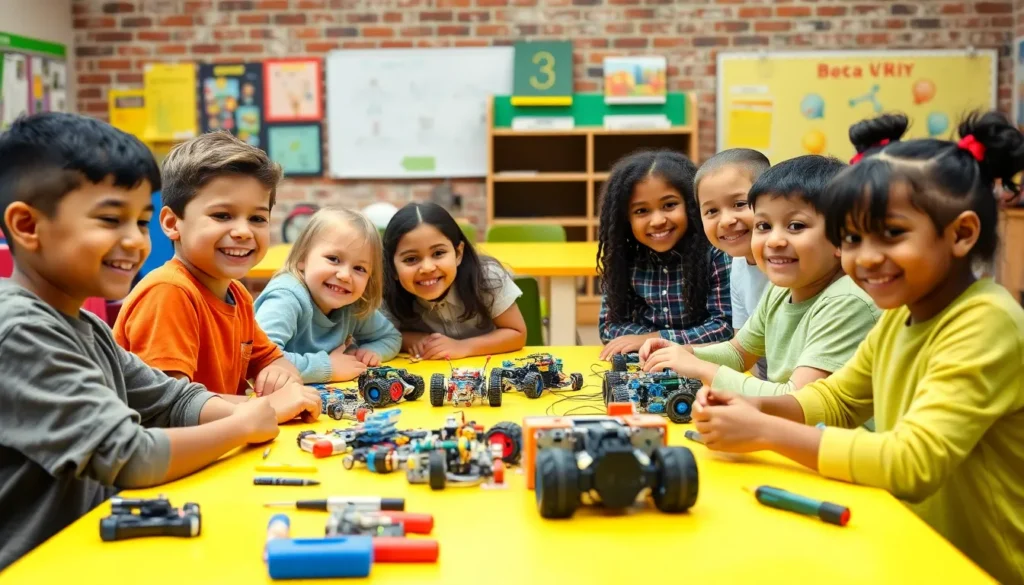In a world where technology reigns supreme, STEM learning kits are the superheroes of education, swooping in to save the day for curious minds. These kits transform the daunting realms of science, technology, engineering, and math into engaging adventures that even the most reluctant learners can’t resist. Who knew that building a robot could be more fun than binge-watching that latest series?
Table of Contents
ToggleOverview of STEM Learning Kits
STEM learning kits serve as innovative tools that enhance education by making complex subjects approachable. They incorporate hands-on activities that promote engagement in science, technology, engineering, and math. Various types of kits are available, targeting different age groups and skill levels, which allows learners to explore concepts at their own pace.
These kits typically include components such as building materials, coding software, and experiment guides. Schools and parents utilize them to supplement traditional educational methods. The hands-on nature of STEM kits fosters creativity and critical thinking, essential skills for the future workforce.
Students develop problem-solving abilities while engaging with real-world challenges presented in these activities. For instance, constructing a simple circuit not only reinforces electrical concepts but also enhances teamwork among peers. Many education experts recognize the significance of fostering a love for STEM subjects early on through these kits.
Challenges posed in the kits often mirror real-world scenarios, making learning both practical and relevant. Interactivity remains a key feature, as students learn by doing rather than simply observing. Incorporating technology, like coding apps, exposes learners to software development and design principles.
Data shows that over 75% of educators believe in the effectiveness of STEM kits in increasing student interest in related subjects. By participating in engaging projects, students feel a sense of accomplishment and curiosity that drives further exploration in STEM fields. Overall, these kits not only enhance academic performance but also prepare young learners for future opportunities in science and technology careers.
Benefits of Using STEM Learning Kits

STEM learning kits offer various benefits that enhance educational experiences. They actively engage students and promote essential skills.
Encouraging Critical Thinking
STEM kits challenge students to think critically and solve problems creatively. Engaging in hands-on projects exposes learners to real-world challenges, pushing them to analyze and evaluate different approaches. As students work through complex tasks, they develop logical reasoning and decision-making skills. This active participation reinforces their understanding of concepts, making learning more impactful. Data shows that practicing critical thinking helps improve academic performance, leading to better outcomes in mathematics and science subjects.
Fostering Collaboration
Collaboration takes center stage when students use STEM learning kits. Working in groups promotes teamwork, communication, and social skills among peers. Students share ideas, encourage one another, and collectively solve problems. This interaction enhances their learning experience, making concepts more relatable and comprehensible. Projects completed in pairs or teams often yield richer insights and innovative solutions. Additionally, approximately 75% of educators recognize that collaborative efforts in project-based learning increase engagement and interest in STEM subjects.
Types of STEM Learning Kits
STEM learning kits come in various types, each designed to engage learners in unique ways. These kits cater to different interests and skill levels, providing diverse hands-on experiences.
Robotics Kits
Robotics kits ignite curiosity about engineering and technology. Students assemble components to create robots that can perform tasks, enhancing problem-solving skills. They learn about sensors, motors, and programming languages. Engaging with robotics not only fosters creativity but also promotes critical thinking. Educators report that students engaged with robotics kits show increased interest in STEM fields. Over 70% of participants in robotics programs express enthusiasm for further STEM learning.
Science Experiment Kits
Science experiment kits inspire exploration of scientific concepts through practical experiments. Students conduct hands-on activities related to chemistry, physics, and biology, allowing them to apply theoretical knowledge. These kits often come with detailed instructions and materials necessary for experiments. Users typically enjoy the excitement of observing reactions and solving problems firsthand. According to educators, 80% of students involved in science experiments show improved understanding of core scientific principles.
Coding Kits
Coding kits introduce learners to programming in an engaging manner. They contain software and hardware elements that teach coding concepts through interactive projects. As learners write code, they understand how to create apps and games. This hands-on experience reinforces logic and computational thinking. Surveys indicate that 75% of educators find coding kits effective in increasing student interest in technology. Students often express increased confidence in their programming skills, leading to further exploration in computer science.
Choosing the Right STEM Learning Kit
Selecting an appropriate STEM learning kit involves considering various factors, including age and skill level. Tailoring choices to meet specific needs enhances engagement and maximizes learning outcomes.
Age Appropriateness
Different age groups require different types of STEM kits. Preschoolers benefit from simple, colorful kits that introduce basic concepts through play. Elementary students often engage with kits that incorporate hands-on experiments, fostering curiosity. Middle school learners thrive with more complex projects, allowing them to explore engineering and coding principles in greater depth. High school kits typically focus on advanced topics, including robotics and software development. Choosing a kit designed for a specific age group enhances the learning experience and keeps students motivated.
Skill Level Considerations
Skill level influences the effectiveness of a STEM learning kit. Beginners should start with fundamental kits that introduce core concepts through basic activities. Intermediate learners benefit from kits that challenge them while still providing necessary guidance, promoting independent problem-solving. Advanced students require kits that present real-world challenges, allowing them to apply their skills creatively. Opting for a kit that aligns with individual skill levels ensures that learners feel confident and supported as they explore STEM fields.
Popular STEM Learning Kits on the Market
STEM learning kits offer a variety of engaging experiences that cater to different interests and age groups. Robotics kits attract students by allowing them to assemble robots while learning about motors and programming. Many users express enthusiasm for further exploration in STEM, with over 70% showing interest after using these kits.
Science experiment kits provide hands-on activities that delve into chemistry, physics, and biology. Participants often report improved understanding of fundamental principles, with 80% of students recognizing their enhanced grasp of scientific concepts during exercises.
Coding kits introduce programming through interactive projects. Students develop logic and computational thinking skills, which enhances their technical abilities. Approximately 75% of educators find coding kits effective in increasing student interest in technology.
Crafting kits typically emphasize creativity and innovation. These kits engage students in design and engineering processes beyond traditional STEM subjects. Many learners discover new hobbies and talents through these activities, fostering both passion and skill.
3D printing kits enable students to explore design and manufacturing concepts. Users gain hands-on experience with technology that shapes the modern world. Success with these kits often leads to positive sentiments about pursuing future careers in engineering or design.
Environmental science kits educate students about sustainability and ecological principles. Participants learn the importance of ecological balance through experiments and projects. Engaging with these ideas promotes awareness of global issues, which resonates with many learners.
Each type of kit complements classroom learning while providing practical applications. Varied hands-on experiences cultivate critical thinking, collaboration, and problem-solving skills, positioning students for success in future STEM pursuits.
STEM learning kits are revolutionizing the way students engage with science, technology, engineering, and math. By offering hands-on experiences that foster creativity and critical thinking, these kits prepare learners for future challenges in an increasingly tech-driven world.
Their ability to make complex subjects accessible ensures that students of all ages can explore and enjoy STEM concepts at their own pace. With a variety of kits available, each designed to cater to different interests and skill levels, the potential for growth and discovery is immense.
As educators and parents recognize the value of these tools, the foundation for a more innovative and skilled workforce is being laid, encouraging a lifelong passion for learning in STEM fields.






